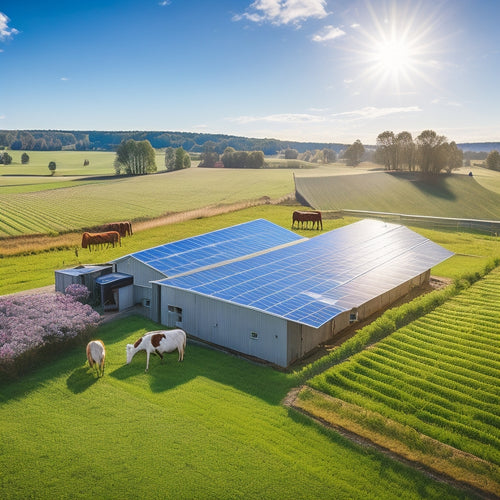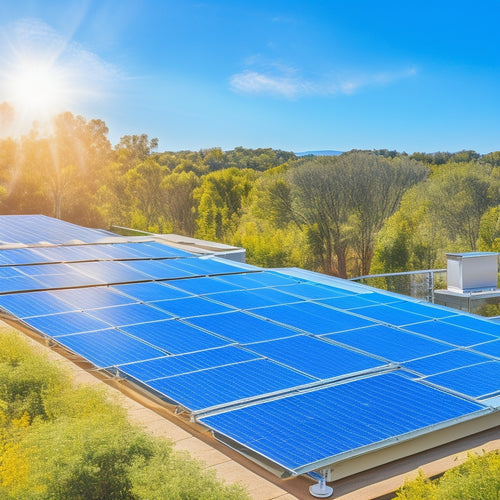
Transitioning to Renewable Power Generation for Businesses
Share
Shifting to renewable power generation can greatly reduce your business's energy costs by over 50%, while enhancing your sustainability profile. By adopting renewable sources, you mitigate risks associated with fluctuating energy prices and gain access to financial incentives. This move not only helps in lowering your carbon footprint but also positions you as a leader in environmental responsibility, appealing to eco-conscious customers. Smart technologies optimize energy usage and improve operational resilience, enabling long-term energy price stability. As you investigate this shift, you'll uncover strategies that can further enhance your financial and environmental benefits.
At a Glance
- Transitioning to renewable power reduces energy costs, potentially leading to zero monthly expenses and over 50% savings on bills.
- Financial incentives, such as tax credits and grants, enhance investment viability and return on investment for renewable projects.
- Implementing energy management systems optimizes energy usage, reducing operational costs and improving sustainability efforts.
- Conducting energy audits helps identify inefficiencies, enabling informed decisions on adopting energy-efficient technologies and renewable sources.
- Long-term contracts for renewable energy provide predictable pricing, aiding in budget forecasting and reducing exposure to market volatility.
Cost Savings Over Time
Investing in renewable power generation can lead to significant long-term financial benefits for your business. By reducing energy expenses, you'll free up resources that can be redirected towards growth and innovation.
Furthermore, commercial solar installations can potentially lead to zero monthly energy expenses and substantial energy bill reductions that can exceed 50%. Over time, these savings can substantially enhance your bottom line, making the shift to renewable energy not just an ethical choice, but a smart financial strategy.
financial incentives and tax benefits further contribute to the viability of this investment.
Long-term Financial Benefits
Shifting to renewable power generation not only aligns your business with sustainability goals but also reveals considerable long-term financial benefits. By embracing renewable energy, you're tapping into various financial incentives that can improve your capital allocation strategy. These incentives often include tax credits that directly impact your bottom line, allowing for enhanced investment returns over time.
Moreover, energy diversification reduces your reliance on traditional energy sources, mitigating risks associated with fluctuating energy prices. This approach enables better risk assessment and strengthens your budget forecasting, ensuring that you remain agile in an ever-changing market.
As you investigate funding opportunities, consider how renewable energy projects can be financed through grants and loans, further enhancing your financial viability.
Ultimately, integrating renewable power generation isn't just about immediate savings; it's about solidifying your financial future. The combination of reduced operational risks and improved cash flow from energy efficiency can considerably strengthen your business's resilience and growth potential.
Reduced Energy Expenses
Embracing renewable power generation leads to considerable reductions in energy expenses, creating a more predictable and manageable cost structure for your business.
By shifting to renewable sources like solar or wind, you're not just investing in a greener future; you're also cutting down on your monthly energy bills. The upfront costs may seem intimidating, but you'll start seeing savings that compound over time.
Government incentives can further enhance these savings, offering tax credits and rebates that greatly lower your initial investment.
These financial enhancements make renewable investments more accessible, allowing you to redirect funds towards innovation and growth rather than fluctuating energy costs.
As energy prices continue to rise, having control over your energy source shields you from unpredictable market shifts.
You'll find that the stability of renewable energy can free you from the constraints of traditional energy providers.
Ultimately, moving to renewable power isn't just a smart financial move; it's a step toward greater independence and sustainability for your business.
Environmental Impact Reduction
Switching to renewable power generation isn't just about saving money; it's also a strategic move to reduce your carbon footprint.
By utilizing sustainable resources, you're actively contributing to a healthier planet while enhancing your brand's reputation.
Moreover, changing to solar power considerably reduces carbon emissions and decreases reliance on fossil fuels, which can lead to substantial energy savings.
Embracing this shift not only meets regulatory demands but also positions your business as a leader in environmental responsibility.
Carbon Footprint Mitigation
Mitigating your carbon footprint is no longer just a choice; it's an essential strategy for businesses aiming to reduce their environmental impact. Currently, consumers and stakeholders increasingly prioritize sustainability. By embracing carbon offset strategies, you can effectively counterbalance your emissions while demonstrating your commitment to a greener future.
Consider investing in renewable certifications, which not only validate your sustainable practices but also enhance your brand's credibility. Certifications can differentiate you in a crowded marketplace, attracting eco-conscious customers who value responsible companies.
Implementing these strategies can lead to tangible benefits, including cost savings in energy and improved operational efficiency.
Moreover, reducing your carbon footprint can open doors to new partnerships and funding opportunities. Businesses that prioritize sustainability often find it easier to collaborate with like-minded organizations and access green financing options.
It's a win-win situation: you protect the environment while potentially enhancing your bottom line.
Sustainable Resource Utilization
After taking steps to mitigate your carbon footprint, the next logical move is to focus on sustainable resource utilization, which directly contributes to environmental impact reduction.
By embracing renewable resources and sustainable practices, you can enhance energy efficiency and optimize resource allocation, ensuring that your business operates in harmony with ecological balance.
Implementing green technologies is essential for advancing your sustainability agenda. You'll find that energy diversification not only lowers dependency on fossil fuels but also provides a buffer against market volatility.
Renewable incentives can further catalyze your shift, making it easier to invest in sustainable sourcing and innovative solutions.
Effective resource management is vital. Regularly assess your operations to identify areas where you can improve efficiency and reduce waste.
Technology Integration Benefits
Integrating smart grid technologies and energy management systems can greatly enhance your business's renewable power generation capabilities.
By leveraging these tools, you can optimize energy usage, reduce costs, and improve overall operational efficiency.
Additionally, investing in energy-efficient appliances and conducting energy audits can further streamline your energy consumption and promote sustainability energy efficiency improvements.
Embracing this technology not only increases your bottom line but also reinforces your commitment to sustainability.
Smart Grid Technologies
Smart grid technologies are revolutionizing the way businesses approach energy management, offering a suite of integration benefits that enhance efficiency and sustainability.
With grid resilience at the forefront, these technologies enable you to adapt to fluctuations in energy demand. By employing smart meters and real-time monitoring, you gain understandings into consumption patterns, enabling better energy forecasting and more effective demand response strategies.
Integrating automated controls and data analytics allows for seamless infrastructure upgrades, ensuring that your energy systems can handle decentralized generation sources like solar and wind. This not only enhances your renewable integration efforts but also reduces reliance on traditional energy sources, promoting greater freedom in your energy choices.
Moreover, smart grid technologies facilitate a fluid energy environment where you can optimize your operations. You can respond to energy price signals in real-time, making informed decisions that align with your sustainability goals.
By utilizing these innovative solutions, you position your business as a leader in the shift to renewable power, ultimately driving down costs and enhancing your competitive edge in a developing market.
It's time to adopt the future of energy management and reveal the full potential of smart grid technologies.
Energy Management Systems
Many businesses are uncovering the revolutionary potential of Energy Management Systems (EMS) in optimizing their energy usage and reducing costs. By integrating EMS, you can enhance energy efficiency and streamline power sourcing, ultimately achieving significant savings.
These systems facilitate system optimization, allowing you to manage energy demand more effectively and respond to fluctuating grid conditions through demand response strategies.
With strong performance monitoring, EMS provides real-time observations into your energy consumption patterns, enabling you to make informed decisions. This user engagement drives operational resilience, enabling your team to take proactive measures in energy management.
Additionally, the grid interconnection capabilities of EMS help you align with renewable energy sources, ensuring compliance with regulatory standards while maximizing your sustainability efforts.
Assessing Energy Consumption Patterns
To effectively shift to renewable power generation, you need to analyze your current energy usage closely.
Conducting energy audits can help identify inefficiencies and optimize your energy strategy, ultimately reducing costs.
By identifying peak consumption times, you can optimize your energy strategy and reduce costs.
Understanding these patterns not only supports a smoother energy shift but also enhances your overall operational efficiency.
Analyzing Current Energy Usage
Understanding your business's energy consumption patterns is essential for identifying opportunities to enhance efficiency and reduce costs. By conducting energy audits, you can gain a clearer representation of how and when your energy is used. These audits not only highlight areas for improvement but also set usage benchmarks that can guide your future energy strategies.
When you analyze your current energy usage, you'll uncover trends that may surprise you. Are there specific times when your energy demand spikes unexpectedly? By pinpointing these patterns, you can take proactive measures to mitigate excessive costs. This analysis enables you to make informed decisions, whether it's investing in energy-efficient technology or exploring renewable energy options that align with your business goals.
Moreover, understanding your energy consumption allows you to communicate effectively with stakeholders about your sustainability initiatives. As you shift to renewable power generation, this knowledge serves as a solid foundation for creating a more sustainable future.
Embracing energy efficiency not only encourages a sense of freedom from rising energy costs but also positions your business as a leader in responsible energy use. Take charge of your energy narrative today.
Identifying Peak Consumption Times
Analyzing your energy usage not only reveals trends but also helps pinpoint peak consumption times that can greatly impact your energy costs.
By understanding your peak load, you can implement demand response strategies to manage those high-demand periods effectively. Usage patterns throughout the day often reveal when your energy consumption spikes, allowing you to adopt time-of-use pricing strategies to minimize costs.
Utilizing energy forecasting and consumption analytics, you can identify these critical moments, enabling you to make informed decisions.
Consider load shifting to redistribute energy usage from peak times to off-peak hours, maximizing grid flexibility and reducing expenses.
Usage profiling is essential; it helps you evaluate which efficiency measures could be applied to lower your overall consumption.
Long-Term Energy Price Stability
When you invest in renewable energy, you're securing predictable energy costs for your business.
Unlike traditional energy sources, which can fluctuate wildly, renewables offer a stable pricing model that can help you budget more effectively.
This long-term price stability not only protects your bottom line but also enhances your overall financial planning.
Predictable Energy Costs
As businesses increasingly adopt renewable energy sources, they uncover an essential benefit: predictable energy costs. This predictability enhances your budget forecasting and allows for more accurate financial planning. With renewable energy, you can utilize fixed pricing models through long-term energy contracts, which shield you from the unpredictable nature of market volatility.
Cost transparency is another key advantage. You gain a clear understanding of your energy expenses, enabling effective operational budgeting. This clarity helps in developing strong investment strategies, as you can allocate resources confidently, knowing your energy costs won't fluctuate dramatically.
Moreover, renewable energy enhances your risk management capabilities. By reducing dependence on fossil fuels, you minimize exposure to external price shocks and political instability that can disrupt traditional energy markets. Instead, you can focus on creating a sustainable business model that supports your long-term goals.
Ultimately, predictable energy costs enable you to make informed decisions, ensuring your business thrives in an ever-changing environment. Shifting to renewable energy isn't just an ethical choice; it's a smart financial move that promotes freedom and stability in your operations.
Frequently Asked Questions
What Are the Initial Costs Associated With Renewable Power Adoption?
When you consider renewable power adoption, the initial investment can seem intimidating. However, these costs often lead to significant long-term savings, ultimately granting you more freedom and flexibility in your financial planning.
How Can Businesses Select the Right Renewable Energy Source?
When selecting the right energy source, evaluate your needs like a sailor steering the sea. Consider factors like availability, cost, and sustainability. This careful source evaluation will guide you toward a brighter, freer future.
What Incentives Are Available for Transitioning to Renewable Energy?
You'll find various incentives for renewable energy, including tax credits, government grants, renewable loans, and favorable energy tariffs. These options not only reduce costs but also enable you to adopt sustainable practices confidently.
How Long Does It Take to See Energy Savings?
Seeing significant savings takes time, but with energy efficiency, you'll usually notice benefits within months. Adopt the long-term benefits of smart choices today, and you'll enjoy financial freedom tomorrow as your costs decrease.
Can Businesses Still Use Fossil Fuels Alongside Renewable Energy?
Yes, you can integrate fossil fuels with renewable energy in hybrid systems. This approach gives you flexibility and reliability, allowing you to optimize energy use while gradually reducing dependency on fossil fuels for a sustainable future.
Explore More
As you maneuver through the changing terrain of energy, think of your business as a ship charting a course through turbulent waters. Shifting to renewable power is your sturdy sail, catching the winds of cost savings, environmental responsibility, and technological advancement. By evaluating your energy consumption like a skilled navigator, you'll not only reach the shores of long-term price stability but also steer towards a brighter, sustainable future. Welcome this voyage—it's not just beneficial; it's essential.
Related Posts
-

What Do I Need to Know About Farm Solar Panels
When considering farm solar panels, you need to assess costs, benefits, and technical specifics. Initial investment c...
-

What Types of Solar Energy Devices Are Available
You'll find several types of solar energy devices available today, each customized to different energy needs. Photovo...
-

High-Efficiency Solar Battery Chargers for Remote Areas
High-efficiency solar battery chargers are essential for your off-grid energy needs in remote areas. They maximize en...


